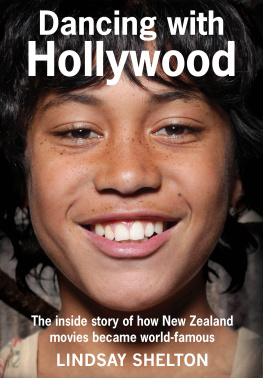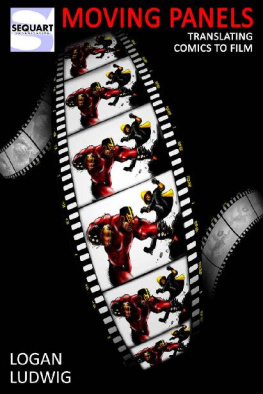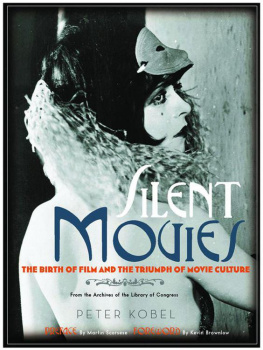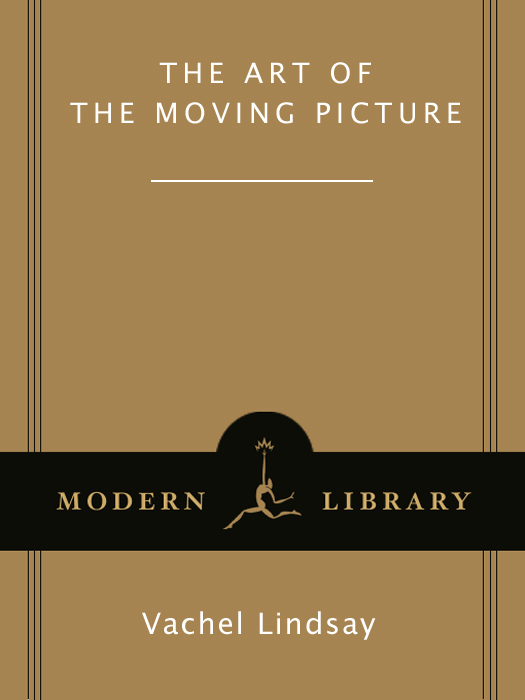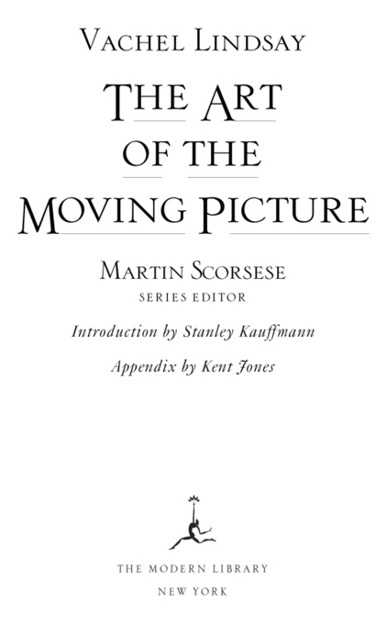ALSO FROM MODERN LIBRARY: THE MOVIES
The Making of 2001: A Space Odyssey
Agee on Film,
by James Agee
Memo from David O. Selznick,
edited by Rudy Behlmer
2000 Modern Library Paperback Edition
Series introduction copyright 2000 by Martin Scorsese
Introduction copyright 2000 by Stanley Kauffmann
Appendix copyright 2000 by Kent Jones
All rights reserved under International Pan-American
Copyright Conventions. Published in the United States by Random House, Inc., New York, and simultaneously in Canada by Random House of Canada Limited, Toronto.
M ODERN L IBRARY and colophon are registered trademarks of Random House, Inc.
LIBRARY OF CONGRESS CATALOGING-IN-PUBLICATION DATA
Lindsay, Vachel, 18791931.
The art of the moving picture/Vachel Lindsay.
p. cm.
Originally published: New York: Macmillan, 1915.
eISBN: 978-0-307-76965-7
1. Motion pictures. I. Title.
PN1994.L5 2000
791.43dc21 99-42461
Modern Library website address: www.modernlibrary.com
v3.1
I NTRODUCTION TO M ODERN L IBRARY: T HE M OVIES
Martin Scorsese
When as a small boy I first fell in love with the movies, I discovered a book by Deems Taylor entitled A Pictorial History of the Movies at our local branch of the New York Public Library. It was the only film book that I knew about, and I borrowed it time and time again. A Pictorial History was just that, a chronological collection of movie stills accompanied by brief descriptions of the movies from the silent-film era to 1949. It was the first course in my film education. Its beautiful black-and-white images re-created the visions and emotions of the movies Id already seen, and allowed me to dream about the others.
It wasnt until some thirty years later that I was able to own a copy of the book (it had gone out of print and was difficult to find). The late Roddy McDowall also grew up with the Deems Taylor book. As a child actor, he would take it on the set and get the cast and crew to sign the stills of the movies on which they had worked. The How Green Was My Valley page, for instance, was eventually signed by John Ford, Maureen OHara, and Walter Pidgeon. This treasured book awoke in me the desire to collect as many film books as possible. There are now one thousand or so books in my library, covering the past one hundred years of movie history, which I use constantly for information and inspiration.
In the Modern Library: The Movies Series, we are publishg some of the classics in the field: personal accounts from movie artists as well as works by film historians and critics in a variety of literary forms. Since the Cave Age there has been a constant battle about the supremacy of the word over the image. Although film is primarily a visual medium, it combines elements from all the artsliterature, music, painting, and dance. For my first list of books, I have chosen two that reflect the felicitous merger of words and images: one by a literary journalist and the other by a poet. I have also chosen two books written in different forms: a collection of memos and a firsthand testimony on the making of a movie classic.
The movies discussed in these books range from early silent films to one of the most modern and innovative films ever made, from obscure lost films to Hollywood extravaganzas. By happenstance, this first list focuses on American movies; foreign films will be included in later seasons. It is my hope that these books will appeal to movie lovers and film professionals alike, and that theyll recreate some of the movie magic I felt as a child with that first book borrowed from the library.
I NTRODUCTION
by Stanley Kauffmann
This is a joyous and wonderful performance, said Francis Hackett when he reviewed this book in the New Republic of December 25, 1915. He then went on to call it a bold and brilliant theory, really bold and really brilliant, and takes first place as an interpretation of the greatest popular aesthetic phenomenon in the world.
Hackett was certainly not alone in praising the book. Gordon Craig, the great man of the theater whom Lindsay urges to enter films, wrote to the author from Rome suggesting that they found a film studio together. D. W. Griffith was moved to ask Lindsay to be his guest at the New York premiere of Intolerance. Victor O. Freeburg, who taught what surely must have been one of the first college film coursesat the School of Journalism of Columbia Universityused the book as a text. Herbert Croly, the editor of the New Republic, invited Lindsay to be the magazines film critic. (Lindsay wrote occasional reviews during 1917.) Comment on the book was wide and intense.
But it has virtually disappeared. Although most film historians know the book, very few contemporary film enthusiasts, in my experience, are even aware of its existence. It has been out of print for many years. The revised edition of 1922, reprinted here, is scarcer than the original of 1915. Lindsays biographers pay it scant attention. Edgar Lee Masters, who published a biography of Lindsay in 1935, disparages The Art of the Moving Picture. Eleanor Ruggles, who published a biography in 1959, does not deal with it in any significant way. Yet, out of the mass of Lindsays poetry and prose, this may be the work most worthy of survival. And in the field of film aesthetics, it is the first important American work, still important.
In several ways it is dated and cranky. It is hyperbolic and self-appointedly supreme. (Just glance at the table of contents, under .) But its hyperbole and its large claims are not matters really of blindness or conceit, they are right out of the best in Lindsays character, which dealt mainly in largenesses, and out of his enthusiasm for the film, which insisted and insisted, and was right.
Nicholas Vachel Lindsay was born in his familys house in Springfield, Illinois, in 1879 and died in the same house in 1931. For this man to whom the everyday was magical, Springfield itself was the mystic, where I always live, wherever I may be. His father was a physician; his mother was active in religious missionary work. His parents sent him to a sectarian college in 1897, but he left in 1899, having found what he thought was, for him, a better vocation to express Christ. He wrote to his parents: Now that I have found it must be Art, I must learn to preach my purpose into other artists.
He spent four years studying painting at the Art Institute in Chicago, then moved on to New York where he studied for another year under Robert Henri. (Among his fellow-students were Rockwell Kent, George Luks, and George Bellows.) He had long been interested in poetry, had begun to write it, and now began to show it to magazines. Then, on Henris kindly but firm advice, he turned away from painting and concentrated on poetry. He had no luck in trying to place an illustrated book of his poems with a publisher, so he took a dramatic step. In March, 1905, he printed one hundred copies each of two of his poems at his own expense. Inspired, says Miss Ruggles, by the stories of President [Theodore] Rooseveltwho, when up against stubborn opposition, was said to bypass the entrenched powers and go with his case straight to the peopleand also by the troubadors of old, he put the poems in his overcoat pocket and went out into the streets of New York to sell them. Possibly, too, he had been influenced by his mothers missionary example.


